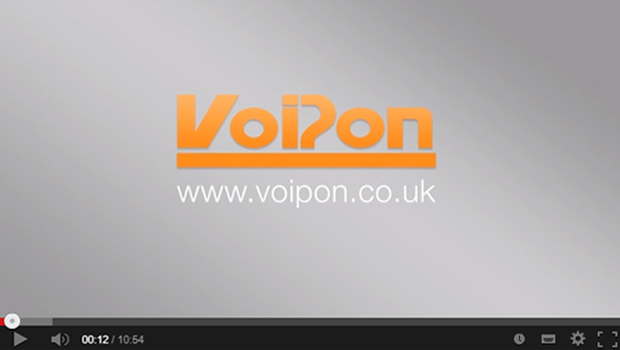
Last week, VoIPon attended CeBIT and had the opportunity to interview a selection of industry leaders to learn about new products and any product developments they were launching at the show.
VoIPon Interviews Sangoma @ CeBIT 2010
VoIPon: Hello, My name is Alexis Argent, I’m the sales manager for VoIPon Solutions in the United Kindgom and I’m joined here with David Mandelstam, CEO and Founder of Sangoma Technologies and I just want to ask how you’re getting on with the show?
David: Thank you very much Alexis. Um. The show is great for us. Here at CeBIT we’re showing our range of cards. As a new product, we’re showing this transcoding card, which is not quite released yet. It’s a card that will do up to 480 channels of audio transcoding, that’s G.711 or G.722, G.723 any of the audio codecs. It will about 140 video codecs – video becoming much more important these days. And that will do the translation from codec to codec without any load on a PC. We’re releasing this probably in a month’s time. It’s part of our commitment to total quality that we’re providing for the open source community in particular.
We are beginning to supply our cards with our own commercial control and signalling stack, rather than using the open source stacks, because we believe that even on an open source system, where we’re responsible for the TDM gateway, we need to take responsibility for all parts of the system, including the signalling stack. So, one can continue to use the open source signalling stacks, that’s fine, but you can use a professional stack when you use our cards, simply because we feel that we owe it to our customers.
Alexis: Fantastic. When did you say was the release date for the transcoding card?
David: Somewhere from around one month to six weeks time. Not all the video codecs will be supported by that time, but all the audio codecs will be supported.
We also have a bigger card which will do up to 2600 simultaneous audio transcodings or 800 video transcodings. So this should be quite useful in the gateway market for people who are building SS7 gateways, SS7 to sip gateways, or PRI to SIP gateways, quite often people need large numbers of transcoding sessions.
With our Sangoma A108 in a standard size PC gateways of that type will handle 960 calls. So being able to handle about half of that in video transcoding is about right, which is one of these cards. If you need more, then you just put in two. They are fairly inexpensive compared with competitive products.
Alexis: Fantastic. Thanks ever so much for taking my interview today. It’s been a pleasure.
David: Thank you.
Alexis: Cheers!
VoIPon Interviews AVM @ CeBIT 2010
VoIPon: My name is Alexis. I’m a sales manager for VoIPon Solutions, United Kingdom. I’m joined here with Matt Tyler out of Germany. We’re here at CeBIT 2010. How are you finding the show?
Matt Tyler: Hey Alexis, good to see you and VoIPon. It’s very nice to have you here. The show is going good. We’ve got a lot of international customers here today. Telecoms, internet service providers, some resellers, and a lot of fans, as you see here at the stand. It’s one of the fullest stands at the CeBIT.
Alexis: Well, I know, it’s a very popular stand. The AVM is always extremely popular and crowded.
Matt: We’re on our home turf here. Hopefully we’ll have a similar experience there in the UK at the upcoming UC show.
Alexis: Are there any new products to talk about?
Matt: Yeah. One of the things that AVM tries to do at the CeBIT and at shows like this is to really show working new products. We’re an innovative company. And we’ve got things like the wireless LAN with 3×3 MIMO, as an idea, that we’re showing. It’s up to 450mbps, as the speeds on this, as the theoretical speeds of the wireless LAN.
Dual concurrent wireless access points, two access points, on one router. We’ve got a Docsis 3 cable router that we’re showing today. And this is also an integrated access device. Meaning it’s got wireless LAN; it’s got cable or DSL modem integrated, VoIP in a micro PBX, USB host for sharing, mass storage, using a 3g mobile stick, or connecting your printer and making that available to the network.
Alexis: So there are stacks of applications associated with all these technologies?
Matt: Software is making a difference here. What we’re putting into it. Sometimes you’re finding similar hardware chips. What we’re doing all the software on this ourselves. Making it very usable for the customers, bringing these new technologies like VoIP or IP TV to the average customer.
Alexis: Oh fantastic. I’m glad to hear you guys are doing well and we’re happy to represent the product.
Matt: I appreciate that. One more thing I’ll go on about here real quick is DECT—the idea of handsets. It’s an old technology to use. We’re integrating DECT with something called CAT IQ, which is the next standard for DECT/CAT. It’s interesting because you have more data bandwidth and you can do internet applications, like RSS feeds.
Alexis: Uh ha
Matt: So you come to AVM FRITZ!Box, you put the web address of your RSS feed and you’ll see that on your DECT handset.
Alexis: Yeah
Matt: Or podcasts or web radio or streaming mp3s from your own network or storages. So fun stuff like that, but also good applications for business as well.
Alexis: Well that’s great, I’m glad to hear that AVM is still kicking butt then!
Matt: Yeah
Alexis: Fantastic!
Matt: Yeah, yeah we’re on top of it!
Alexis: Thanks very much for the interview.
Matt: It’s very good to see you.
Alexis: Cheers.
VoIPon Interviews Pika Technologies @ CeBIT 2010
VoIPon: Hello. My name’s Alexis, I’m from VoIPon Solutions. I’m a sales manager. I’m joined here with Maarten Kronenburg from Pika Technologies who is the managing director. Yeah, and I’m happy to be here. How are you finding the show?
Maarten: Well, we are very happy to be on the CeBIT show in 2010. CeBIT looks to be a really good show. The first day was a bit slow. The second and third day are really good. The weather was terrible, it’s cold here, we had snow yesterday, but the people are very warm, and they’re very interested in Pika WARP.
Alexis: Oh excellent! So you you’re having fun?
Maarten: We’re having fun. Oh absolutely!
Alexis: That’s great. I hear you have a new GSM module that’s coming out very soon.
Maarten: Well, in fact, Alexis, it’s good that you bring that up. As the people that are watching this video may know, we are offering this WARP appliance already for a good year now, and so far it’s been focussing on fixed line telephony and we’ve had a fair degree of success offering this device as a PBX with Asterisk. However, we also saw a market for wireless communication and wireless connectivity. So we have a new GSM module that you already alluded to, it uses GSM.
I’ll open up this device and here is the GSM module. As you can see, the device has two connectors for to connect to an antenna. Here you can put a SIM card in from the outside, and here are two more spots for two more SIM cards, that will be supported in the near future. These ones already are supported, ah so you can sort of switch between SIM cards. So per module you can connect two antennas and in a WARP you can put two modules, so that means the math is you can put four GSM calls in a single WARP.
Alexis: Fantastic. And what kind of release date do you got for these?
Maarten: The current release date is somewhere in the month of April and we are currently beta testing it. And as the watchers of this video maybe know, it’s early March now. We’re still holding our beta trials. Things are looking good. We can place calls. In fact we do have a demo here at the CeBIT show where you can ring a German number and it rings this telephone, so it’s working. There is a number of small little items that we need to iron out, but I do believe that it’s minor.
Alexis: So you’ll be ready then? Fantastic. Well thanks ever so much for the interview Maarten. Cheers.
Maarten: Thank you. And watchers of this video buy the module at VoIPon!
Alexis: Cheers.
VoIPon Interviews Patton Inalp Electronics @ CeBIT 2010
VoIPon: Hello, My name is Alexis Argent, I’m the sales manager for VoIPon Solutions in the UK. I’m here with Doug Hill who is president of sales for the UK and Europe and I just want to see how you’re getting on at CeBIT 2010?
Doug: It’s a good show, again. It’s still one of the premier shows in Western Europe. And you’ve got a full plethora of IT companies here showing their wares and everything. And obviously we’re here and we’re very excited to be here again this year. And it’s been a good show for us.
Alexis: So you’ve got a new product to show us?
Doug: Yeah, we’ve got one new product that I’d really like to tell you about. Basically, what it is, it’s a session border controller router. Now, typically, if you look at Voice over IP networks, a session border controller will sit on the network edge. And it will service 300-400 customers. And some of the functionality: there is transcoding, disaster recovery, VPN tunnelling, quality of service, etc.
What we’ve seen at Patton Inalp, that there is a real requirement to move that functionality out to the customer premise. So in light of that, what we’ve done is we’ve come up with two new products, a SmartNode 5200 and a SmartNode 5400 session border controller routers. And what these devices do is that they move the session border functionality to the customer premise, instead of the edge of the network. Because if you take a look at almost all VoIP networks, the bottleneck is typically at the customer premise, it’s not at the edge of the network. So by moving this functionality out, what we can provide at the customer premise now is transcoding. To take one codec that it is high bandwidth, transcode it into a lower codec to go across a wide area network connection, broadband connection, where you might have limited bandwidth.
We can do quality of service. We’re one of the only companies in the market that I’m aware of that does what we call downstream quality of service. We can actually monitor traffic, slow down the downstream traffic and make sure that you have a very high quality voice connection for the end user. Then we can offer things like VPN connection, disaster recovery. Uh, one of the transcoding features we offer is the ability to transcode from G.711 fax to T.38 fax. So all this functionality moves out to the customer premise to where it should be, and now we actually work all these different functions at the customer premise where the bottle neck is, instead of sending everything across that bottleneck and performing those functions at the edge of the core network. So we’re very excited about this product.
Alexis: Oh very interesting. What’s the availability? Did you say it’s available yet?
Doug: The product is available right now, okay: the SmartNode 5200 and the 5400. The 5400 does transcoding. The 5200 does not do transcoding, but it has all of the other session border controller functionality that I mentioned.
Alexis: Oh fantastic. Well thanks very much for the interview. I really appreciate it.
Doug: It’s my pleasure
Alexis: Cheers
Doug: Cheers.
VoIPon Interviews snom technology @ CeBIT 2010
VoIPon: Hello my name is Alexis, I’m a sales manager at VoIPon Solutions in the United Kingdom and I’m joined here with Christian Baier, from snom technology, and we’re here at CeBIT 2010. Thanks so much for taking this interview.
Christian: Hi Alexis.
Alexis: How are you finding the show?
Christian: It’s great. It’s a great resonance here in terms of our new products. The snom M9 for example, the new SIP DECT phone, the snom Vision which is the extension module for the eight series, and our new paging system which is called, snom PA1, and general interest is very high in terms of the snom Microsoft OCS edition, so this is also very high resonance here.
Alexis: What are the main differences between the snom M3 and the M9? I understand that you own sort of more of this technology and you have more control over the hardware and the firmware, and the OCS wasn’t available on the M3 but it is on the M9.
Christian: This is true yes. In fact, we made the software on the M9 on our own. So the few changes are that you can now connect up to nine handsets to one base station instead of eight to one base station like the M3. You can make up to four concurrent phone calls, instead of three like. The M9 is also IPv6 ready and it’s meant as well to be OCS version 6 ready, to be connected natively to the Microsoft Office Communication Server 2007.
Alexis: And the availability of the M9?
Christian: Will be something after summer.
Alexis: After summer sometime?
Christian: Yes, after summertime.
Alexis: Oh fantastic. What about the expansion module you have. It works with the 8 series, does it?
Christian: Not just works only with the 8 series.
Alexis: What is the name of it again?
Christian: It’s the snom Vision. It will be available as well in summertime. It not just works with the 8 series. It’s thought to be some kind of extension module that can be placed to the 8 series. But in fact it’s a standalone device that’s connected on Power over Ethernet. And you can make some extension lines from your colleagues for example there and dial them directly. You can make some video stream via middleware, and of course yeah, write your own application for the snom Vision and benefit of the open source technology of the snom Vision.
VoIPon Interviews Grandstream Networks @ CeBIT 2010
VoIPon: My name is Alexis, I’m a sales manager for VoIPon Solutions in the United Kingdom and I’m here with Grandstream, Vytas, who is a Sales Manager for Europe. Thanks for taking the interview.
Vytas: Absolutely, my pleasure.
Alexis: How are you finding the show?
Vytas: Very good so far. It’s been the third day, very busy. A lot of resellers, distributors a lot of new potential clients. I actually feel much better about the show this year than the last year. So much more opportunities, so I’m looking forward for the next couple of days.
Alexis: Oh fantastic. Do you have any new product developments that you can talk to us about?
Vytas: Absolutely. We brought our new video surveillance line, first time, to the CeBIT. We released quite a few products during the year. On the surveillance side, we have up to five cameras at this moment, high definition and low light as well. A couple of the cube cameras and standard cameras. We have all the cameras running on the POE, it runs on H.264 codec. Also some of them have a built in microphone so it’s a lot of potential and also the entire solution is compatible with our PBX system. And we have a couple of encoders: one port all the way up to four ports, so it converts analogue signal into IP.
Alexis: I see. So the surveillance market is obviously a new market for Grandstream. The availability of those products – what are they looking like? Are they available?
Vytas: The products are available right now, actually, we just introduced a newer line, our dome camera, a few weeks ago and we’re working developing on a new product, that we’re going to announce, a couple of them, on IFSEC, unified, a show in Birmingham sometime in May. So we’re working on that side of it, and so on the VoIP side, we’re releasing a couple of new products, new living products, and also many new applications allow a new video phone.
Alexis: Oh fantastic. It sounds like you’ve got quite a full roadmap there.
Vytas: It’s a lot busy. A lot of potential in the roadmap. You know, company’s growing. We’re growing. We’re adding a lot of new distribution channels.
Alexis: Yeah.
Vytas: Things are looking good so far.
Alexis: That’s great. Well thanks again for your time.
Vytas: Well absolutely. My pleasure.
Alexis: Cheers.







